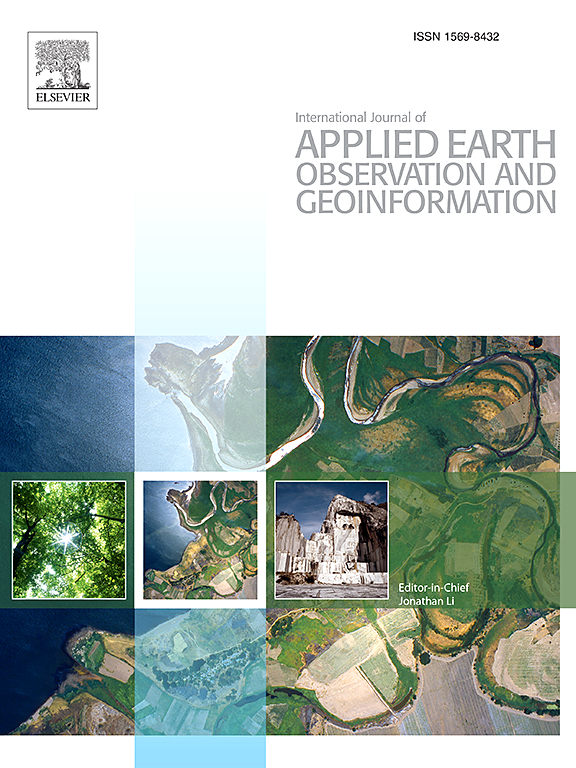Extracting individual trajectories from text by fusing large language models with diverse knowledge
IF 8.6
Q1 REMOTE SENSING
International journal of applied earth observation and geoinformation : ITC journal
Pub Date : 2025-06-09
DOI:10.1016/j.jag.2025.104654
引用次数: 0
Abstract
Individual trajectories offer insights into human mobility, with data either passively recorded, such as GPS, or actively recorded, such as natural language text. While the former provides detailed movement data, it lacks important context such as personal experiences, which can be obtained from the latter. Extracting trajectories from text can enhance travel experience optimization, historical analysis, and pandemic management. However, existing trajectory extraction methods rely on rule-based frameworks that fail to capture contextual semantics, resulting in limited generalizability and loss of trajectory semantics. While general-purpose large language models (LLMs) demonstrate potential for contextual reasoning capabilities, their deficient domain-specific knowledge pertinent to trajectory patterns hinders efficient and precise trajectory extraction. To address these limitations, we propose T2TrajLLM, a novel framework that fuses LLMs with domain knowledge through three components: (1) a lightweight trajectory model for structured guidance, (2) a text-to-trajectory transformation model enabling multi-step reasoning, and (3) labelled text-trajectory samples for learning domain-adaptive constraint rules. Central to T2TrajLLM is a prompt method that dynamically fuses these components with LLMs while avoids rigid rule dependency. Evaluated across three heterogeneous datasets, T2TrajLLM achieves ∼8 % higher accuracy than existing methods, demonstrating strong transferability across datasets and extensibility to diverse application requirements. Overall, T2TrajLLM effectively extracts trajectories from diverse textual sources, providing robust support for the analysis and understanding of individual mobility.
通过融合具有多种知识的大型语言模型,从文本中提取个体轨迹
通过被动记录的数据(如GPS)或主动记录的数据(如自然语言文本),个体轨迹提供了对人类活动的洞察。虽然前者提供了详细的运动数据,但它缺乏重要的背景,如个人经历,这可以从后者获得。从文本中提取轨迹可以增强旅行体验优化、历史分析和流行病管理。然而,现有的轨迹提取方法依赖于基于规则的框架,无法捕获上下文语义,导致其泛化能力有限,丢失了轨迹语义。虽然通用大型语言模型(llm)展示了上下文推理能力的潜力,但它们缺乏与轨迹模式相关的特定领域知识,阻碍了有效和精确的轨迹提取。为了解决这些限制,我们提出了T2TrajLLM,这是一个通过三个组件融合llm和领域知识的新框架:(1)用于结构化引导的轻量级轨迹模型,(2)支持多步推理的文本到轨迹转换模型,以及(3)用于学习领域自适应约束规则的标记文本轨迹样本。T2TrajLLM的核心是一个提示方法,它动态地将这些组件与llm融合在一起,同时避免严格的规则依赖。通过对三个异构数据集的评估,T2TrajLLM的准确率比现有方法高8%,显示出跨数据集的强大可移植性和对不同应用需求的可扩展性。总的来说,T2TrajLLM有效地从不同的文本来源中提取轨迹,为分析和理解个体流动性提供了强大的支持。
本文章由计算机程序翻译,如有差异,请以英文原文为准。
求助全文
约1分钟内获得全文
求助全文
来源期刊

International journal of applied earth observation and geoinformation : ITC journal
Global and Planetary Change, Management, Monitoring, Policy and Law, Earth-Surface Processes, Computers in Earth Sciences
CiteScore
12.00
自引率
0.00%
发文量
0
审稿时长
77 days
期刊介绍:
The International Journal of Applied Earth Observation and Geoinformation publishes original papers that utilize earth observation data for natural resource and environmental inventory and management. These data primarily originate from remote sensing platforms, including satellites and aircraft, supplemented by surface and subsurface measurements. Addressing natural resources such as forests, agricultural land, soils, and water, as well as environmental concerns like biodiversity, land degradation, and hazards, the journal explores conceptual and data-driven approaches. It covers geoinformation themes like capturing, databasing, visualization, interpretation, data quality, and spatial uncertainty.
 求助内容:
求助内容: 应助结果提醒方式:
应助结果提醒方式:


